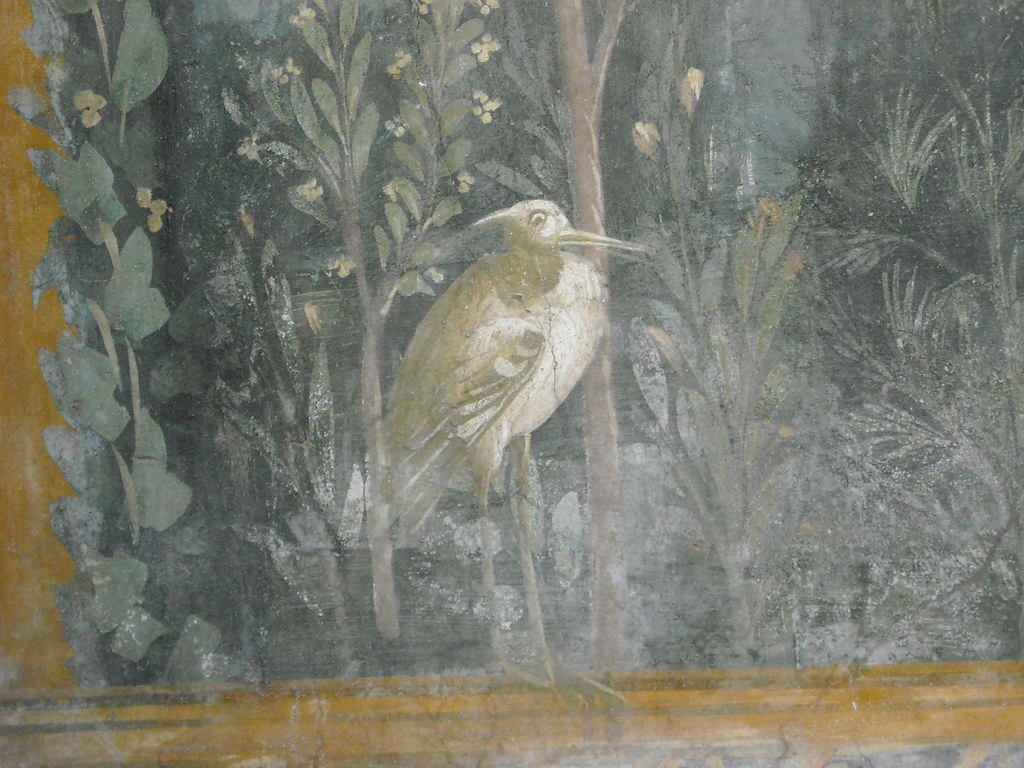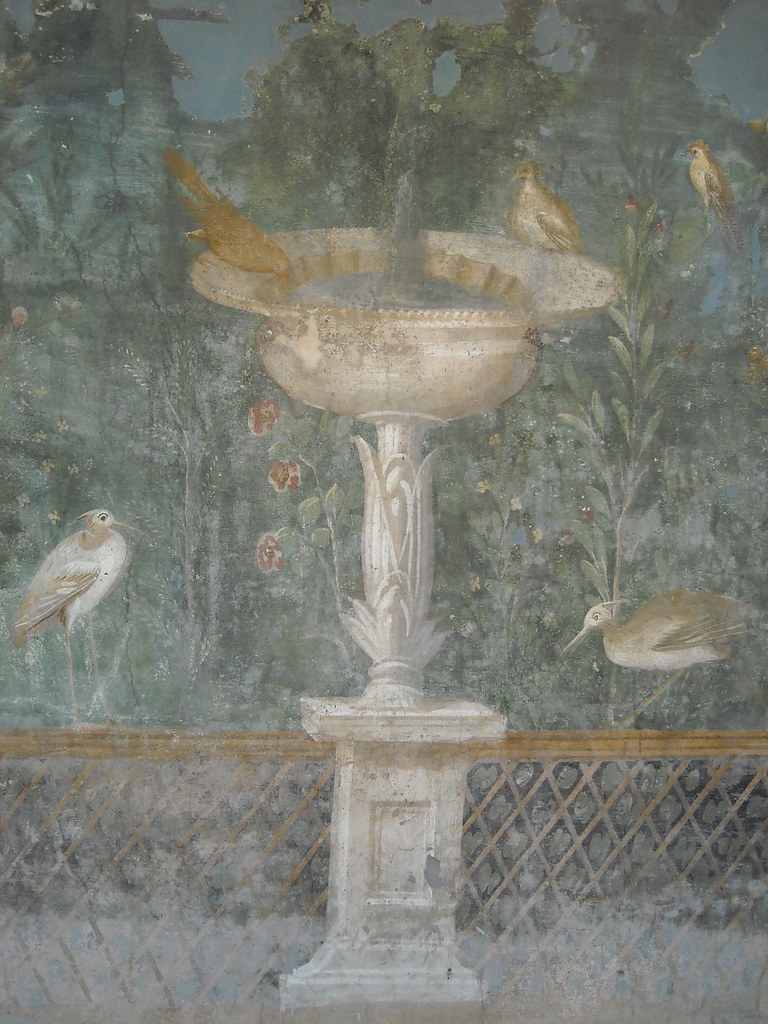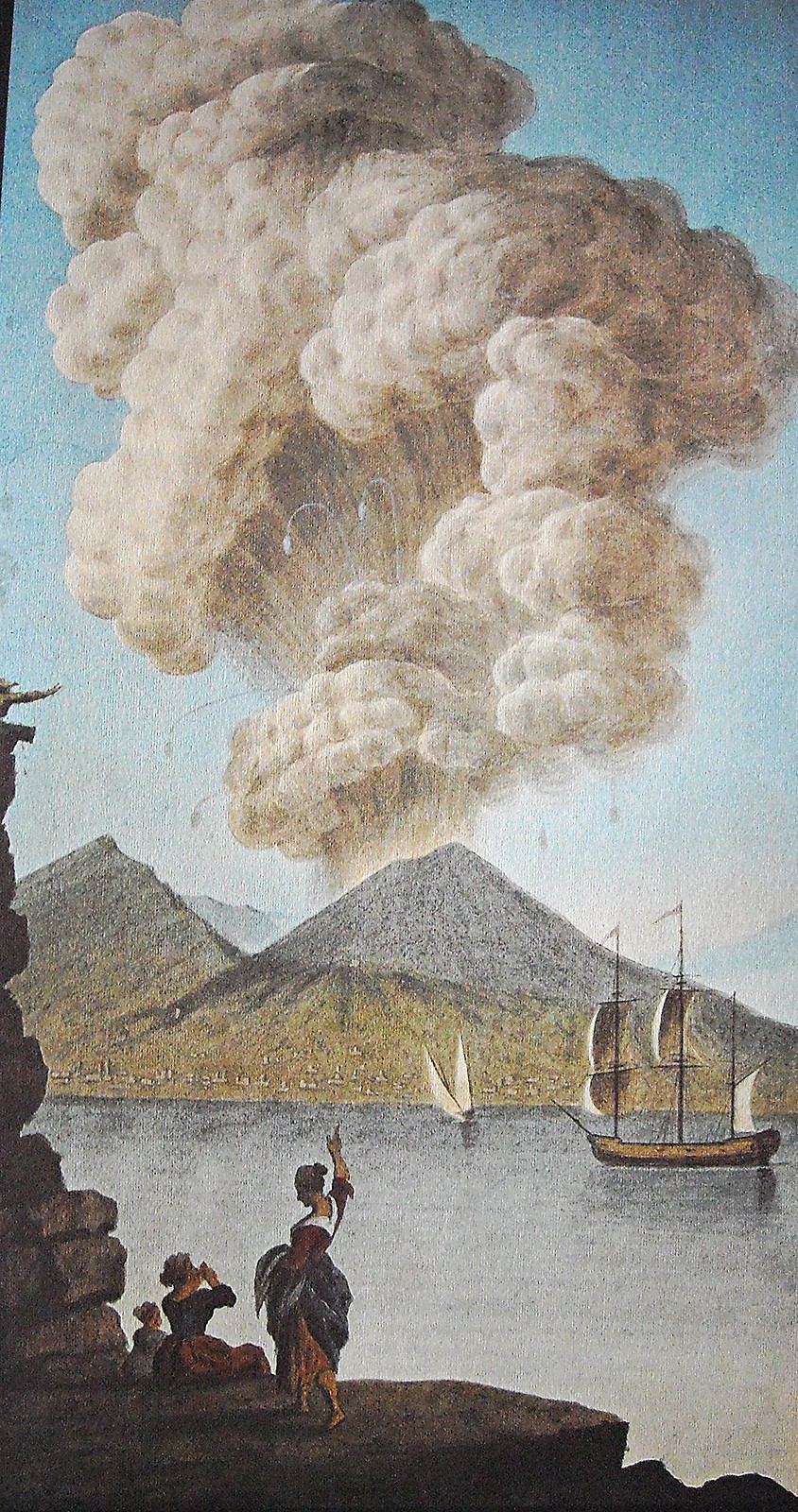.

Fresco, Garden with birds around the fountain, Casa della Venere in Conchiglia, Pompeii: artist unknown, before 79 AD; photo by *Karl*, 28 April, 2012
Yesterday is not a milestone that has been passed, but a daystone on the beaten track of the years, and irremediably part of us, within us, heavy and dangerous. We are not merely more weary because of yesterday, we are other, no longer what we were before the calamity of yesterday.
Samuel Beckett: from Proust (1931)

Fresco, Garden with birds around the fountain, Casa della Venere in Conchiglia, Pompeii: artist unknown, before 79 AD; photo by *Karl*, 28 April, 2012
Fresco, Casa de Cubicoli floreali, Pompeii: artist unknown, before 79 AD; photo by Marcus Cyron, 3 April 2006
Fresco, Casa de Cubicoli floreali, Pompeii (detail): artist unknown, before 79 AD; photo by Marcus Cyron, 3 April 2006
Fresco, Casa del frutetto, Pompeii: artist unknown, before 79 AD; photo by Marcus Cyron, 3 April 2003

Fresco, Casa di Euplia, Pompeii: artist unknown, before 79 AD; photo by Marcus Cyron, 3 April 2006

Excavation of the Temple of Isis at Pompeii: Pietro Fabris. gouache, in Sir William Hamilton: Campi Phlegraei, 1776; image by Marcus Cyron, 16 February 2006

Garden of the Fugitives, Pompeii -- a vineyard in which a group of fugitives attempted in vain to take shelter from the rain of ash and lapilli during the eruption of Vesuvius that destroyed the town in 79 AD. The people, including several children, were suffocated by the fumes of the volcano. In place of their bodies, decomposed with time and completely covered by lapilli, remained the cavities, which were filled with plaster at the time the vineyard was excavated in 1860, allowing archeologists to reconstruct the shape of the victims and reveal the tragedy which occurred in this place: photo by Sören Bleikertz, 2003; image by Simon Eugster, 9 July 2009

Eruption of Vesuvius: Pietro Fabris, gouache, in Sir William Hamilton: Supplement to Campi Phlegraei. Observations on the Volcanoes of the Two Sicilies, as they have been communicated to the Royal Society of London, Naples, 1779: image by *Karl*, 5 September 2013




11 comments:
What an extraordinary way to end the month of September. The Beckett passage really resonates; if resonance can be said to have a direction, it resonates backwards and forward. I love the word "daystone." I think of Pompeiian frescoes and Pompeii itself frequently (I often used to visit the Villa Boscoreale room at the Metropolitan Museum), but it's odd -- I tend to think of the buildings of Pompeii (including the garden paintings on their walls) and the human, animal and insect residents of Pompeii, but never about Pompeii's gardens proper, which so beautifully and fragrantly filled out the reality of the place. It's a tunnel-vision failure of my imagination, which I intend to rectify, so thank you for this and yesterday's Weldon Kees/Robinson posting. That dog picture was amazing and it brought me back to the Robinson poems. Curtis
APPROACH THE RIM OF A VOLCANO
Approach the rim of a volcano
notice its molten ruby cast
the fiery frothing restlessly of roiling spew
walk a little closer to the grate of Hell
and look down past the flimsy iron bars and note
how redder how hotter how angrier and ready to
Well I’ve lost interest in describing it any further
it’s past my bedtime and past my
powers of description or perhaps I just don’t
want to believe in Hell I just want to believe in
grottoes of ivy-clinging rock walls and fountains so
crystalline and plentiful at every turn and in
every vista
Let Hell burn in its own fires
let its roar be muffled in my ears
but authorities better than I warn that it’s near
and won’t be ignored when the body’s spirit is
loosed into its native world
and the pendulum hung from unfathomably high
swings way back this way to show the cool snows and
green valleys of bliss’s endlessness
and then swings way forward to reveal
the atomic migraine the bone-crushing endless cancerous
neuralgia of Hell without letup
and our souls nudged toward the
pendulum’s judicial slice forever into either
one or the other
10/30/2001 (from Where Death Goes, The Ecstatic Exchange, 2009)
Tom,
Thanks for this, resonant (as Curtis says) for me, having arrived today at page 1,000 of Continuum -- what else to do but keep going, onward. . .
9.30
light coming into fog against invisible
ridge, black shape of black pine branch
in foreground, sound of wave in channel
of what to say remains here
instead, after a time
as it appears, thing to see
there, think about in
clouds above shadowed shoulder of ridge,
gull flapping to the right toward point
Again Beckett (from "Proust"):
"...the succession of events spasmodic..."
Breath, canvas and water, burnt woodwork... well, crinolines, too.
Ever onward,
Red Shuttleworth
The excavation of the temple of Isis reminds me of something, what could it be? Wait, it's those coal mines in Virginia! There are some slaves missing in that image. Too relaxed.
I think I will put today's daystone back on the pile.
I know I got a lot of warnings about the calamities of tomorrow. But nobody explained that they would become the calamity of yesterday. I wouldn't have understood anyway. Didn't listen.
Oh Man, can I have a do-over?
No wait a minute, maybe not a good idea.
OK then, I'm going to have a great day and attempt to do good things for other people.
"For most human beings this world is a hell-world"
Harris Schiff
Many thanks to all.
This line of reflection originated in, of all places, York, Nebraska. With this scholar: Wilhemina Feemster Jashemski.
A native of York, graduate of York College, editor of the York Marathon, president of the York Debate Society and the York Forensic Club. Let us give her props. She caused me to think a bit. And then a bit more. They say (well, once said) true scholarship is always an obscure business, by its nature. Perhaps that's its most endearing feature, the modesty, along with the close attention to detail. Not that anything in this post ought to be blamed on her. But, just saying.
For the record:
__
Pompeian Historian Wilhelmina Jashemski
By Joe Holley
Washington Post Staff Writer
Monday, January 14, 2008
Wilhelmina F. Jashemski, 97, a retired University of Maryland professor of ancient history and a Pompeian archaeologist, died of renal failure Dec. 24 at Holy Cross Hospital in Silver Spring.
A longtime Silver Spring resident whose home was surrounded by hundreds of azaleas and other flowering plants and trees, she was a gardener and a scholar of ancient gardens. She knew more about the gardens of Pompeii than perhaps any person since the residents themselves were buried under 15 feet of Vesuvian ash nearly two millenniums ago.
Mrs. Jashemski, who helped establish the academic field of garden archaeology, first visited Pompeii in 1955, two centuries after the buried city was rediscovered. Although Roman law was her specialty, she was interested in Roman gardens, in part because she was a gardener herself. "The Romans loved gardens, and you do, too, so why not work on them?" suggested her husband, Stanley A. Jashemski.
It was a marvelous idea, she told The Washington Post in 1977, but she had one reservation: "It sounded entirely too much like fun to be a serious project."
Deciding nevertheless to write a book about Roman gardens, she assumed that the gardens of Pompeii would be one chapter. They became the work of a lifetime.
She discovered that gardens were an integral part of everyday life in the ancient town, where most of the dwellings were single-family rowhouses with a bit of green space to grow figs, olives, cherries and other fruits and vegetables. Some of the larger gardens, she came to understand, had commercial uses, including as vineyards and nurseries, while others were the settings for small restaurants. Gardens also were a favorite site for religious activities, from animal sacrifices to meditation.
Her discovery of the first intact remains of a good-size vineyard from the era revised perceptions of how the Romans planted and managed grapes, stored and used wine, and worked the land.
She was struck, she told The Post, not only by the tragedy of Pompeii's demise but also by life's continuity, by tools and techniques still in use today. "Life," she said, "is still much the same. Did you know I have never found a garden in Pompeii that did not have a dog?"
Keeping mind that this was a person who was interested in gardening well before she was digging up the ruins of Pompeii.
Wilhelmina Feemster at the Feemster family home on Florida, Avenue, York, Nebraska, displaying her prize tomatoes.
It did strike me that for those caught trying to flee the lava flow and trapped in the Garden of the Fugitives (remembered in the plaster-cast simulacra), Beckett's generally applicable proposition must have taken on an acute particularity. For them, yesterday would have to have been the most exhausting calamity of all... now lasting a virtual eternity.
"Garden archeology" -- how great. Our garden guardians have always been the cats who lived on our terrace. (In Tuxedo Park, NY, we grew all kinds of vegetables in very large pots on a raised, gated terrace; it's really the best way to raise a crop in that formerly deer-rich environment.) The cats kept the smaller animals at bay and when our last outdoor feral passed away, gardening became much chancier. That being said, I would love you all to see and be able to sample this summer's Pennsylvania-grown tomatoes, which really deserved a prize. Prof. Jashemski's work is inspiring. Curtis
Those bodies of dust are always caught up in my mind with the atomic dust shadows at Hiroshima.
I thought the same. That shadow of the missing person on the bridge.
Post a Comment